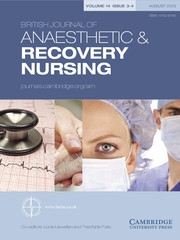Article contents
An introduction to cardiac monitoring and rhythm interpretation
Published online by Cambridge University Press: 25 February 2009
Abstract
This article is the first in a series which will explore the identification and management of cardiac arrhythmias within the peri-operative care setting. To improve patient safety, the number of patients who are monitored within the recovery room is rising, whilst cardiac monitoring remains a fundamental requirement for patient care during the anaesthetic phase. Therefore, the role of the peri-operative care nurse requires an ability to interpret cardiac arrhythmias and to subsequently instigate the appropriate management.
The purpose of this preliminary article is to establish the basic principles that underpin the identification and management of arrhythmias. Cardiac physiology is reviewed and then applied to the derivation of the waveforms of the normal ECG. The article continues with a summary of accurate electrode placement and some tips for troubleshooting in the presence of ‘artifact’. A systematic analysis tool, which can be easily applied to clinical practice, completes the article.
Information
- Type
- Research Article
- Information
- Copyright
- Copyright © British Association of Anaesthetic and Recovery Nursing 2002
References
- 5
- Cited by

